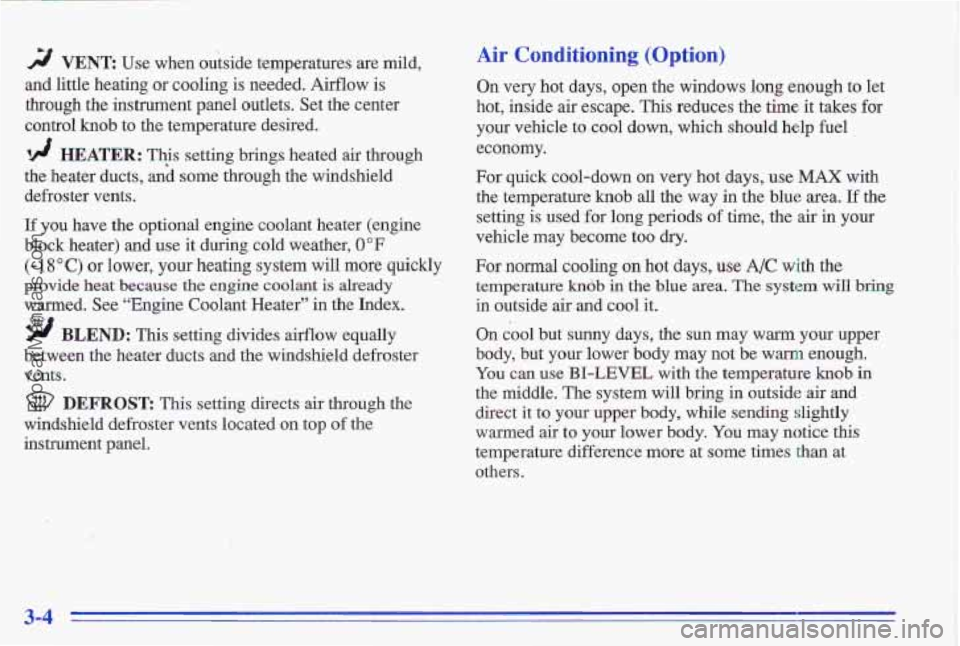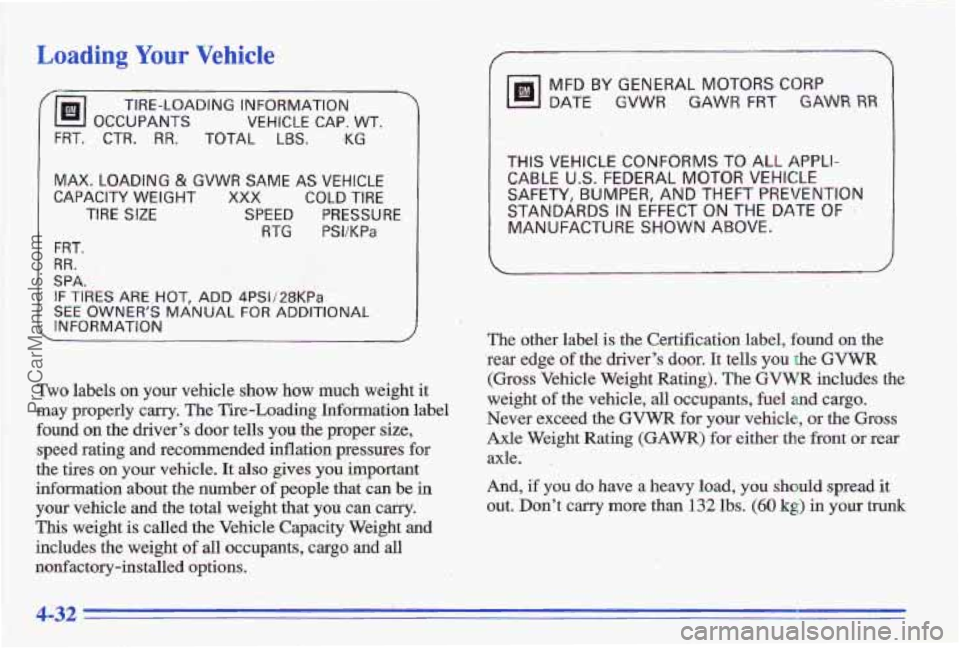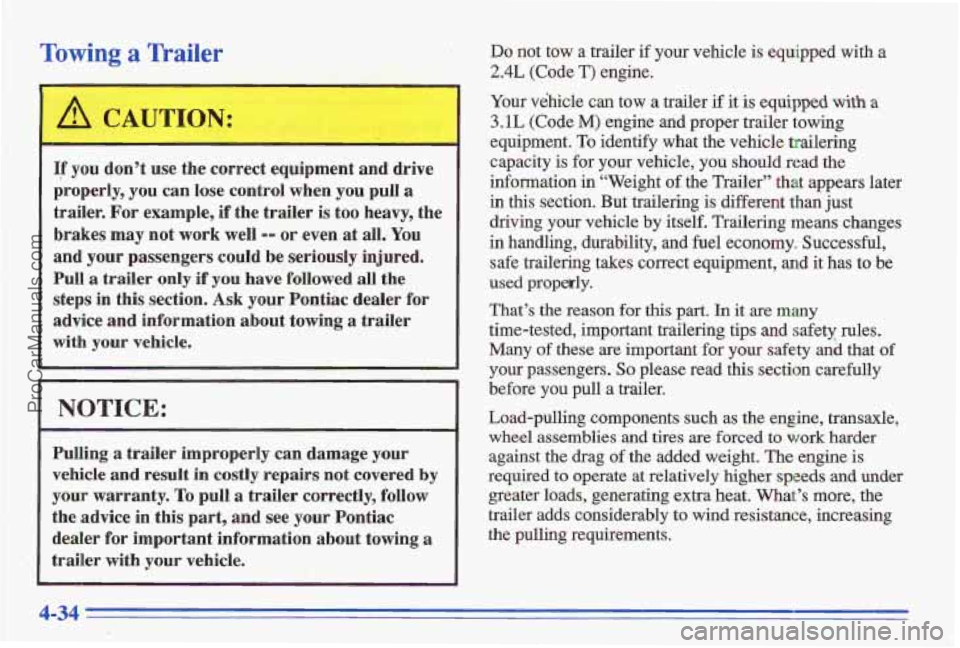1996 PONTIAC GRAND-AM fuel cap
[x] Cancel search: fuel capPage 118 of 356

If the Light Is On Steady
You may be able to correct the emission system
malfunction by considering the following:
Did you just put fuel into your vehicle?
If
so, reinstall the fuel cap, making sure to fully install
the cap. The diagnostic system can determine if the fuel
cap has been left
off or improperly installed. This will
allow fuel to evaporate into the atmosphere.
A few
driving trips should turn the light,off.
Did you just
drive through a! deep puddle of water?
If so, your electrical system may be wet. The condition
will usually be corrected when the electrical system dries out.
A few driving trips should turn the light off.
Are you low on fuel?
As your engine starts to run out of fuel, your engine may
not
run as efficiently as designed since small amounts of
air are sucked into the fuel line causing a misfire. The
system can detect this. Adding fuel should correct
this
condition. Make sure to install the fuel cap properly. It
will take a few driving trips to turn the light
off.
Have you recently changed brands of fuel?
If so, be sure to fuel your vehicle with quality fuel (see
“Fuel” in the Index). Poor
fuel quality will cause your
engine not to run as efficiently as designed. You may
notice this as stalling after start-up, stalling when you
put the vehicle into gear, misfiring, hesitation on
acceleration or stumbling
on acceleration.. (These
conditions may go away once the engine
is warmed up.)
This will be detected by the system and cause the light
to turn on.
If you experience this condition, change the fuel brand
you use.
It will require at least one full tank of the
proper fuel to turn the light
off.
If none of the above steps have made the light turn off,
have your dealer or qualified service center check the
vehicle. Your dealer has the proper test equipment and
diagnostic tools to fix
any mechanical or electrical
problems that may have developed.
ProCarManuals.com
Page 121 of 356

Passlock Warning Light Fuel Gage
THEFT
SYS
This light will come on
briefly when you turn the
key towards the START
position. The light will stay
on until the engine starts.
W
(3
Your fuel gage tells you
about how much fuel you
have left, when
the ignition is
on. When the indicator nears
EMPTY (E), you still have a
little fuel left, but you should
get more soon.
An amber
light
will come on below the
gage when the fuel
tank is
near
EMPTY (E).
If the light flashes,. the Passlock system has entered a
tamper mode. If the vehicle fails to start, see "Passlock"
in the Index.
If the light comes on continuously while driving and
stays on, there may
be a problem with the Passlock
system. Your vehicle will not be protecteil
by Passlock,
and you should see your dealer.
J
Here are four things that some owners ask about. None
of these show a problem with
your fuel gage:
At the service station, the gas pump shuts off b'efore
the gage reads
FULL (F). ' I
It takes a little more or less fuel to fill up than the gage
indicated. For example,
the gage may have indicated
the
tank was half full, but it actually took a little more
' or less than half the tank's capacity to fill the tank.
The gage moves a little when you turn a, corner or
The gage doesn't go back to EMPTY (E) when you
speed up.
turn
off the ignition.
2-65
ProCarManuals.com
Page 126 of 356

rF/ VENT Use when outside temperatures are mild,
and little heating or cooling is needed. Airflow is
through the instrument panel outlets. Set the center
control
knob to the temperature desired.
‘!! HEATER: This setting brings heated air through
the heater ducts, aid some through the windshield
defroster vents.
If you have the optional engine coolant heater (engine
block heater) and use it during cold weather,
0°F
(- 1 8 O C) or lower, your heating system will more quickly
provide heat because
the engine coolant is already
warmed. See “Engine Coolant Heater”
in the Index.
9 BLEND: This setting divides aeflow equally
between the heater ducts and the windshield defroster
vents.
DEFROST This setting directs air through the
windshield defroster vents located on top of the
instrument panel.
Air Conditioning (Option)
On very hot days, open the windows long enough to let
hot, inside air escape. This reduces the time it takes for
your vehicle to cool down, which should help fuel
economy.
For quick cool-down on very hot days,
use MAX with
the temperature
knob all the way in the blue area. If the
setting is used for long periods
of time, the air in your
vehicle may become too dry.
For normal cooling on hot days, use A/C with the
temperature
kndb in the blue area. The system will bring
in outside air and cool it.
On cool but sunny days, the sun may warm your upper
body, but your lower body may not be warm enough.
You can use BI-LEVEL with the temperature knob in
the middle. The system will bring in outside air and
direct it to your upper body, while sending slightly
warmed air
to your lower body. You may notice this
temperature difference more at some times than at
others.
3-4
ProCarManuals.com
Page 180 of 356

Loading Your Vehicle
/@!!!I OCCUPANTS VEHICLE CAP. WT.
TIRE-LOADING INFORMATION
FRT. CTR. RR. TOTAL LBS. *KG
. ..
MAX. LOADING & GVWR SAME AS VEHICLE
CAPACITY WEIGHT XXX COLD TIRE
TIRE SIZE SPEED PRESSURE
FRT.
RTG PSI/KPa
RR.
SPA.
IF TIRES ARE,HOT, ADD 4PS1/28KPa
SEE OWNER'S MANUAL FOR ADDITIONAL
INFORMATION
Two labels on your vehicle show how much weight it
may properly carry. The Tire-Loading Information label
found on the driver's door tells
you the proper size,
speed rating and recommended inflation pressures for
the tires on
your vehicle. It also gives you important
information about
the number of people that can be in
your vehicle and the total weight that you can carry.
This weight is called the Vehicle Capacity Weight and
includes the weight of all occupants, cargo and all
nonfactory-installed
options.
THIS VEHICLE CONFORMS TO ALL APPLI-
SAFETY, BUMPER, AND THEFT PREVENTION
MANUFACTURE SHOWN ABOVE.
CABLE- U.S. FEDERAL MOTOR VEHICLE
STANDARDS IN EFFElCT ON THE DATE OF
The other label is the Certification label, found on the
rear edge of the driver's door. It tells you the GVMrR
(Gross Vehicle Weight Rating). The GVWa includes the
weight of the vehicle, all occupants, fuel and cargo.
Never exceed the
GVWa for your vehicle, or the Gruss
Axle Weight Rating (GAWR) for either the front or rear
axle.
.
And, if you do have a heavy load, you should spread it
out. Don't carry
more than 132 lbs. (60 kg) in your trunk
4-32
ProCarManuals.com
Page 182 of 356

Towing a Trailer
A CAUTION:
If you don't use the correct equipment and drive
properly, you can lose control when
you pull a
trailer. For example, if the trailer is too heavy, the
brakes may not
work well -- or even at all.. You
and your passengers could be seriously injured.
Pull
a trailer only if you have followed all the
steps in this section.
Ask your Pontiac dealer for
advice and information about towing
a trailer
with your vehicle.
Pulling
a traikr improperly can damage your
vehicle and result in costly repairs not covered
by
your warranty. To pull a trailer correctly, follow
the advice in this part, and
see yumr Pontiac
dealer for important information about towing
a
trailer with your vehicle.
Bo not tow a trailer if your vehicle is equipped with a
2.4L (Code T) engine.
Your vehicle can tow a trailer if it is equipped with a
3.1L (Code M) -engine and proper trailer towing
equipment,
To identify what the vehicle trailering
capacity
is for your vehicle, you should read the
information
in "Weight of the Trailer'' that appears later
in this section. But trailering is different than just
driving your vehicle
by itself. Trailering means changes
in handling, durability, md fuel economy. Successful,
safe trailering takes correct equipment, and it has to be
used propetly.
That's the reason for this
part. In it are many
time-tested, important trailering tips and safe% rules.
Many of these are important for your safety and that of
your passengers. So please read this section carefully
before you pull a trailer.
Load-pulling components such as the engine, transaxle,
wheel assemblies and tires are forced to work harder
against
the drag of the added weight. The engine is
required to operate at relatively
higher speeds and under
greater loads, generating extra heat. What,'s more, the
trailer adds considerably to wind resistance, increasing
the gulling requjsernents.
1'
4-34
ProCarManuals.com
Page 226 of 356

Filling Your Tank
Gasoline vapor is highly flammable. It burns
violently,
and that can cause very bad injuries.
Don’t smoke if you’re near gasoline or refueling
your vehicle. Keep sparks, flames, and smoking
materials away from gasoline.
The cap is behind a hinged door on the right side of your
vehicle.
To open the fuel door, pull the fuel access handle on the
floor by the driver’s seat.
The remote
fuel filler door release can help keep your
kel tank from being siphoned. Always be sure the fuel
door is closed and latched after refueling.
6-4
ProCarManuals.com
Page 227 of 356

While refueling, hang the tethered cap inside the fuel
door.
To take off the cap, turn it slowly to the left
(counterclockwise).
~~ ~ ~
If you get gasoline on yourself and then
something -ignites it, you could be badly burned.
Gasoline can spray out on you if you open the
fuei filler cap too quickly. This spray can happen
if your tank
is nearly full, and is more likely in
hot weather. Open the fuel filler cap slowly and
wait for any
“hiss” noise to stop. Then unscrew
the cap
all the way.
Be careful not td spill gasoline. Clean gasoline from
painted surfaces as soon as possible. See “Cleaning the
Outside of Your Pontiac” in theJndex.
When you put the cap back on, turn it to the right until
you
hear at least three clicks. Make sure you fully install
the cap.;The diagnostic system can determine
if the fuel
cap has been left
off or improperly installed. This would
‘allow fuel to evaporate into the atmosphere. See
“Malfunction Indicator Lamp” in the Index.
ProCarManuals.com
Page 228 of 356

NOTICE:
If you need a new cap, b'e sure to get the right
type.
Your dealer can get one for you. If you get
the wrong type, it may not fit or have proper
venting, and your fuel tank and emissions system
might be
damaged.
Things that burn can get on hot engine parts and
start
a fire. These include liquids like gasoline,
oil, coolant, brake fluid, windshield washer and
other fluids, and plastic
or rubber. You or others
could b'e burned. Be
careful not to drop or spill
things
that will burn onto a hot engine.
Checking "'lings Under the Hood
r
An electric fan under the hood can start up and
injure
you even when the engine is not running.
Keep hands, clothing and tools away from any
underhood electric
fan.
The following sections tell you how to check fluids,
lubricants and important parts underhood.
TO open the hood, first pull
the handle inside the
vehicle.
ProCarManuals.com